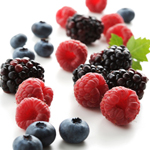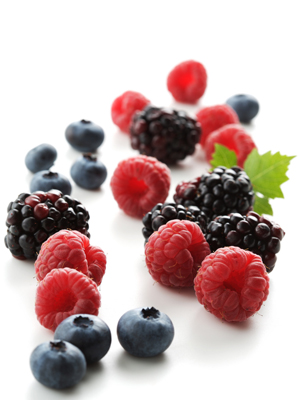If you’ve seen a cut apple turn brown, then you’ve seen cellular rust at work. This is what happens when free radicals, unstable molecules that are products of oxygen, poach electrons from healthy cells. Free radicals abound from outside sources, like cigarette smoke and sun damage, and can cause everything from wrinkles to heart disease to cancer. This is why you need antioxidants: they scavenge free radicals in the body before they can damage cells, tissues and DNA.
Some of the best-known antioxidant foods are rich in vitamins C and E, beta-carotene, flavonoids and selenium. Here are the ones you should have on your plate:
Berries
Sprinkle a handful of berries on your breakfast cereal and you’re on your way to slowing down oxidative damage. Cranberries, blueberries, raspberries and blackberries scored top points in the latest study on antioxidants. These vibrant berries are rich in Vitamin C, manganese, and polyphenolic compounds, all of which contribute to their antioxidant strength. Their skins also contain anthocyanins, dark blue and red colour pigments that help fight infection, improve digestive health and promote healthy aging.
Garlic
They may call it the stinking rose, but garlic has sweet antioxidant power “ a storehouse of sulfur-containing compounds, manganese, and vitamins B6 and C. So smash a couple extra cloves into salad dressing, soup and pasta dishes.
Beans
Bean counters unite. They are a major source of fiber, high in protein, but low in fat. They are inexpensive and versatile. And just a half a cup of beans contains skyrocketing antioxidant levels. Choose from chick or split peas, kidney or pinto beans “ the varieties are as endless as the recipe possibilities.
Broccoli
These little trees contains beta-carotene and indole-3-carbinol compound, an antioxidant that breaks down and helps eliminate estrogen in the body. Studies show that this helps decrease the risk of estrogen-sensitive ovarian and cervical cancers.
Tea
Bring on the brew. Green tea contains antioxidant flavonoids known as catechins “ one cuppa has 200 mg of catechins, the equivalent of eating eight apples. Colour doesn’t matter much though “ experts agree that both green and black tea are super-concentrated antioxidant sources, with up to 10 times the amount of free-radical scavenging polyphenols in a mere mug.












Comments